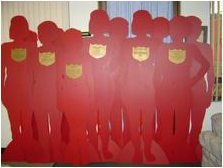The Dead Among Us

October 15, 2009
Silhouettes of dead people stood in UMB hallways for the past week in an effort to raise awareness of domestic abuse and its effect on society. The hope is that these wooden effigies, a part of a national event called The Silent Witness Exhibit, will encourage people to pay attention to signs of abuse on coworkers and friends.
To usher in Domestic Abuse Awareness month this October, several organizations at UMB came together in an effort to help stop the epidemic of violence. Officer Clara Molina, from the Campus Police Department, is heading this effort.
“As a police officer I feel it is my responsibility to raise awareness and to educate people about domestic violence because it affects so many people here in our community,” Molina said in an interview.
The Silent Witness Exhibit began in 1990 when the growing number of domestic homicides in Minnesota caught the attention of a group of female artists and writers. This prompted them to form the Arts Action Against Domestic Violence (AAADV) group.
The goal of this organization was to honor those who had lost their lives and to give the epidemic of abuse national attention. The event they put together became the first Silent Witness exhibit.
They created 27 life-sized wooden human silhouettes to represent the 26 women killed in Minnesota in 1990. The 27th one represented the countless other victims still living or whose deaths had been unreported, or mislabeled.
They called these figures Silent Witnesses, and on February 18th, 1991, over 500 women escorted these witnesses in silent procession to the Minnesota state capitol where a press conference was held.
The outpouring of emotion from the women speakers and sheer size of the demonstration caught national attention and soon Silent Witness Exhibits began taking place all over the country.
Today silent witness exhibits have been established in all fifty states due to the tireless efforts of Janet Hagberg and Jane Zeller who made it their personal mission to end domestic homicide in the United States.
The exhibit, on display last week at UMB, is up to date with stories of men and women killed in 2008 and 2009. It is designed to be shocking, depressing and even enraging, Officer Molina said. It may cause some students extreme emotional distress, because it hits close to home.
Anyone who feels they need to meet with a therapist or a counselor to talk about problems they or a friend are having in their home should call the UHS counseling Center at 617-287-5690 and make an appointment. Or they can visit the Health Services office on the second floor of the Quinn Administration building, she said.
The UMB police department is working closely with the Women’s Center to arrange this event. Charlotte Valentine, the coordinator of the Women’s Center, is proud to be a part of the project.
“Students should feel free to come to the Women’s center for information on volunteering for abuse support programs like women’s shelters and resources for dealing with an abusive relationship,” she said.
Deborah Cohen is a therapist who works in the Health Services Counseling Center.
“Anyone can be a victim of domestic abuse, while man to women abuse is the most common it can occur in gay and lesbian relationships as well,” said Cohen.
Abuse happens gradually in a relationship, she said. At first the abuser may be a loving person but their jealousy, their need to control others, to feel in control will lead them to become possessive and eventually abusive.
“When a person says something like I love you so much I can’t stand when you go out with your friends because of all the other guys, or forbidding the other people from going places without them,” Cohen said.
There are lots of pamphlets at the women’s center and in Health Services that explain the spiral into domestic abuse. Many of them talk about low self-esteem being a factor in how the person being abused accepts abuse and they condemn society’s quiet acceptance of it.
“If you know someone who is the victim of abuse, and want to help him or her, remember to approach the issue in a sensitive way,” Cohen said. Often abusers will blame the abused for their actions and because of the time they spend together it might be hard for the abused to reject this notion. Focus on the safety of the abused person and encourage them to seek counsel.The best thing to do is to be there to listen and to be supportive.




















































